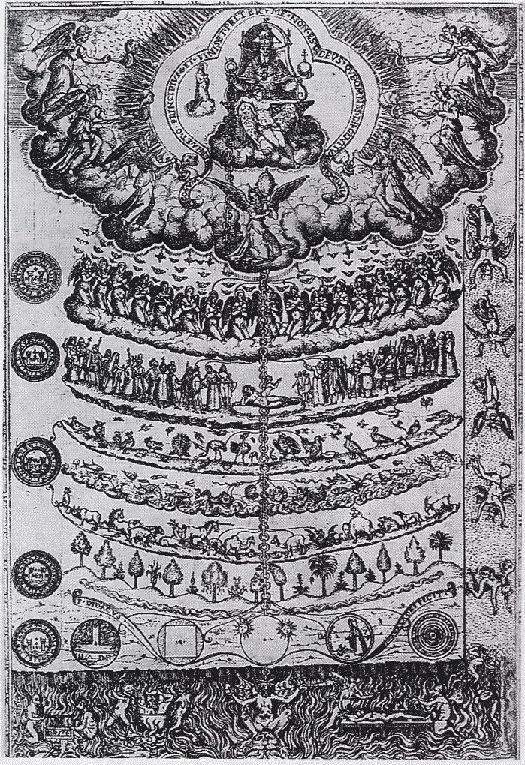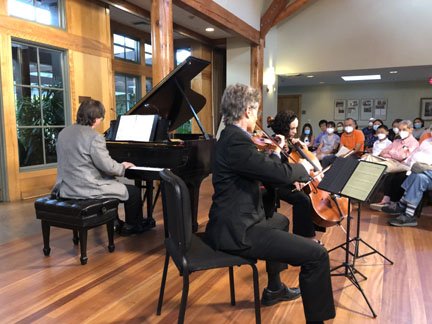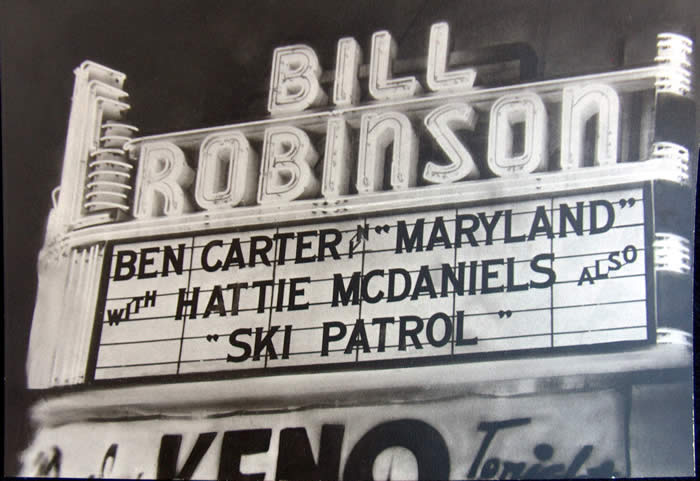
The Three Kinds of Music
for Violin, Violoncello, and Piano
February 21--June 5, 2010
Duration: about 20 minutes
TKM was premiered on my
Feb. 22, 2011 concert at Duke University. Eric Pritchard, violin; Stephanie Vial, cello; Vincent van Gelder, piano
video (YouTube) premiere
1rst performance MP3 recording
WAV recording
TKM was performed a second time on a Ciompi Summer Chamber Music Series
concert at Sarah Duke Gardens, Duke University, on August 3, 2022. Eric
Pritchard, violin; Elizabeth Anderson, cello; Brandt Fredriksen, piano. Recording and video by Mark Manring.
video (YouTube) Second performance
2nd performance MP3 recording
WAV recording
Full Score, legal-size
(PDF)
Cover
Legal-size
is best for pianists reading from printed scores on paper. For
electronic music readers, letter-size is more suitable.
Full Score, letter-size
(PDF)
Parts are in two versions, both letter-size. The first is for either paper or electronic music readers.
Conventional Parts
The second is only for electronic music readers, and has each part enlarged with the other staves reduced.
EMR Violin Part EMR Cello Part
I. Human Music
Allegro pidooma
[6:41]
II. Angel Music
Namaha Shivaya [7:03]
III. Devil Music
Allegro boogerini: Piu boogerini: Meno
boogerini:
Allegro boogerini: Adagio: Piu boogerini
[6:12]
 I wrote The Great American
Piano Trio in 1983 that was premiered at my senior recital at UNT (then
NTSU) in Denton, Texas in 1984. I had hoped that my uncle, a cellist teaching
at Vanderbilt, would take it up, but this did not happen, and as there was no
further interest in this piece I scrapped it. However there was some very good
material in the work, especially in the last movement, and I further developed
this for jazz band in 1990 as the “Allegro boogerini” movement of the Popular Music of Planet X. (This piece has
since been entirely re-written for concert band, without the boogerini, then
again re-written for piano quintet, and orchestrated to be Symphony No. 1: PMPX.)
I wrote The Great American
Piano Trio in 1983 that was premiered at my senior recital at UNT (then
NTSU) in Denton, Texas in 1984. I had hoped that my uncle, a cellist teaching
at Vanderbilt, would take it up, but this did not happen, and as there was no
further interest in this piece I scrapped it. However there was some very good
material in the work, especially in the last movement, and I further developed
this for jazz band in 1990 as the “Allegro boogerini” movement of the Popular Music of Planet X. (This piece has
since been entirely re-written for concert band, without the boogerini, then
again re-written for piano quintet, and orchestrated to be Symphony No. 1: PMPX.)
In the last few years I have started associations with local musicians and
performances are now possible for chamber works. I returned to writing a piano
trio in February 2010, with a new first movement. Then I took the Allegro
boogerini and recast it, condensed from the jazz band version, back into piano
trio format, amended and improved, as the final movement, “Devil Music”. Given
this evocative title, the first movement turned into “Human Music”, which gave
me the great challenge of the middle movement, which had then to be “Angel
Music”. (You may notice that my angels tend to be despondent, while the demons
have a good time.) This parallels Boethius with his musica mundana, musica
humana, and musica instrumentalis.
"Pidooma", from the tempo marking of the first movement, is an
engineering term denoting the origin of many useful concepts.
This work is dedicated to my close friends and superb musicians, violinist Eric
Pritchard and cellist Bonnie Thron, along with cellist Stephanie Vial and
pianist Vincent van Gelder, who with Eric performed the premiere on February
22, 2011 at Duke University. The photograph is from the second performance with
Eric, cellist Elizabeth Anderson, and pianist Brandt Fredriksen at Sarah Duke
Gardens, August 3, 2022. Eric edited the violin part.
Musician Biographies

Vincent van Gelder, pianist, was born in Rotterdam, The Netherlands. Mr. van Gelder holds BM and MM degrees from
the Conservatory of Hogeschool Enschede and MM in performance from the Southern
Illinois University at Carbondale where his teacher was Wilfred Delphin. In
2003, he graduated with a DMA in piano performance from the University of
Missouri at Kansas City where he studied with Richard Cass.
Vincent currently lives in Greensboro,
North Carolina. He appears regularly as a soloist. Recently he performed at the
Focus on Piano Literature conference
in Greensboro, and also was the soloist for Gershwin’s Rhapsody in Blue with the Greensboro Concert Band.
Stephanie Vial, cellist, is a sought after lecturer,
soloist, and continuo player. She is the co-director and principal cellist of
the Vivaldi Project, and has also performed with such groups as the Atlanta
Baroque Orchestra, Apollo Ensemble, Les Violons du Roy, and the modern/ period
chamber ensemble, Arcovoce. As a baroque cellist, she has recorded for Dorian,
Naxos, Centaur Records, and Hungaroton. Fanfare Magazine, in a review of the
Naxos recording of Quantz flute sonatas, gives “a particular bow to Stephanie
Vial, who manages to make each cello intervention a delight to the ear.” Ms.
Vial received her training on the modern cello at Northwestern University,
followed by a Master’s Degree at Indiana University and a DMA from Cornell University.
She is an adjunct faculty member at UNC-Chapel Hill.
Eric Pritchard,
violinist, has been a
member of Ciompi Quartet since 1995 and was formerly the first violinist of the
Alexander and Oxford Quartets. Mr. Pritchard has taught at Miami University,
San Francisco State University, City University of New York and the North
Carolina School of the Arts. He was winner of the National Federation of Music
Clubs Award in Violin as well as the first-prize winner at the Portsmouth
(England) International String Quartet Competition and the Coleman and Fischoff
national chamber music competitions. He has performed widely as a recitalist
and as soloist with the Boston Pops and orchestras in Europe and South America.
His major teachers were Eric Rosenblith, Josef Gingold, Ivan Galamian and
Isadore Tinkleman and he holds degrees from Indiana University and the
Juilliard School. He has performed many works by Bill Robinson since 2006.
Elizabeth Anderson, cellist,
has performed in major concert venues in many countries. She was a
founding member of the Meloia Quartet, and has performed and recorded
with the Cassatt String Quartet, VC3 Cello Trio, and as cellist in the
NY City Opera Orchestra. She is very involved with Hindustani Raga on
cello and voice. She has served on the faculties of the Eastman School
of Music, Florida State University, Middlebury College, the Longy
School of Music, and UNC-Greensboro.
Brandt Fredriksen,
pianist, is, in the humble opinion of the composer, a highly capable
musician with a great feel for this piece. He has an impressive concert
career internationally, and serves on the artist faculty of the UN
International School and the pre-college piano faculy of Manhatten
School of Music.




 I wrote The Great American
Piano Trio in 1983 that was premiered at my senior recital at UNT (then
NTSU) in Denton, Texas in 1984. I had hoped that my uncle, a cellist teaching
at Vanderbilt, would take it up, but this did not happen, and as there was no
further interest in this piece I scrapped it. However there was some very good
material in the work, especially in the last movement, and I further developed
this for jazz band in 1990 as the “Allegro boogerini” movement of the Popular Music of Planet X. (This piece has
since been entirely re-written for concert band, without the boogerini, then
again re-written for piano quintet, and orchestrated to be Symphony No. 1: PMPX.)
I wrote The Great American
Piano Trio in 1983 that was premiered at my senior recital at UNT (then
NTSU) in Denton, Texas in 1984. I had hoped that my uncle, a cellist teaching
at Vanderbilt, would take it up, but this did not happen, and as there was no
further interest in this piece I scrapped it. However there was some very good
material in the work, especially in the last movement, and I further developed
this for jazz band in 1990 as the “Allegro boogerini” movement of the Popular Music of Planet X. (This piece has
since been entirely re-written for concert band, without the boogerini, then
again re-written for piano quintet, and orchestrated to be Symphony No. 1: PMPX.)